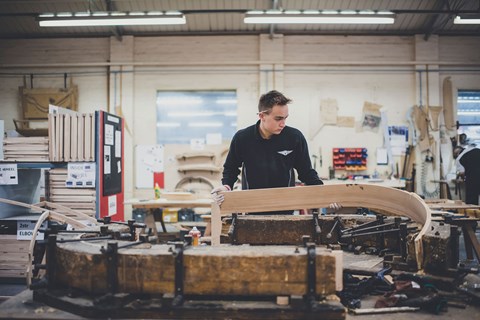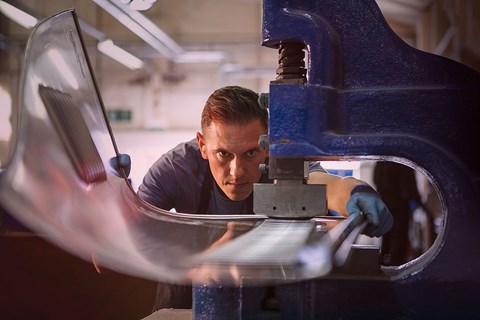► Mark Walton on the Morgan factory
► Inside the Morgan Motor Company
► Factory tour in Malvern, Worcestershire
I visited the Morgan factory in Malvern the other day – me and 30,000 other people. Thankfully not everyone came at the same time, but that, believe it or not, is the number of people who visit Morgan’s red brick sheds every year. This is automotive industry turned into tourism. Welcome to the future.
Not that Morgan isn’t worth a visit. It’s so quaint, it’s like it was invented by a Disney executive. The traditional production line is aided by gravity: cars are born at the top of the hill and they slowly descend the natural slope down a series of gangways that link the succession of workshops.
From the moment you step into the topmost shed – the original, built by Henry Fredrick Stanley Morgan in 1914 – the atmosphere is pungent with history. Framed by bare brick walls, wooden floorboards and exposed steel roof trusses, the top shed acts a museum, but step down a couple of stairs to enter the chassis shop and you find yourself in a messy world of hand tools, power drills, criss-crossing cables, shelves lined with box files and plastic trays full of components, bottles of glue, cans of oil, photos and memos and calendars stuck to the walls. It feels authentic – Disney would never accept this kind of health and safety.
Classic Plus 4s are still made side-by-side with the new alloy-chassis Plus Six. The new model has been a leap for a small manufacturer like Morgan – just the wiring loom of the new BMW engine and gearbox looks daunting, its multi-coloured strands sprawling out like there’s a clown’s plastic wig hanging under the dashboard.

Everyone’s favourite bit of the tour is, of course, the wood shed, where a team of master craftsmen hand-form English ash while getting high on glue fumes all day. Even the new Plus Six has an ash frame, acting as an intermediary between the boxy alloy chassis and those classically curvaceous panels. The ash ‘former’ for the rear wing – a gigantic block of wood with a curved channel cut through it – looks like it was found on the Mary Rose and dredged out of the English Channel. It’s survived so many generations of employee, no one is sure how long it’s been there.
But the thing that surprised me most about my day at Morgan was how busy it was. Instead of exiting through the gift shop, the £24 tour starts here – in the gift shop and the cafe, where I sampled the carrot cake, a perfect Morgan-esque slice, beautifully handmade by skilled artisans.
Visitors gather here, buying their Morgan caps and their Morgan branded fudge, before starting the tour, and it was packed all day. Packed with enthusiasts from around the world, a chattering congregation of English, American, Dutch and German accents. As well as the Tour, visitors can also sign up for Morgan ‘experiences’ – £25 gets you a passenger ride in a three-wheeler. Everyone I saw climbing out looked like they’d spent half an hour on a roller coaster. Or in a giant tumble dryer.

It would be unjust to call this a Morgan theme park, because it’s a working factory, steeped in history. There’s no artifice here, nothing’s contrived, and if the visitors stopped coming the cars would still be made the same way. But Morgan is also a vision of the future, specifically our passion for cars and how that will be expressed in years to come.
If Ford and Mercedes-Benz do survive the revolution (and nothing is certain these days) they’ll end up like Samsung smartphone manufacturers – mass producing plastic cases on wheels with lithium-ion batteries. But a few master craftsmen will continue, like the katana-kaji, the ancient samurai sword makers in Japan, still polishing their blades even though a samurai warrior could be felled by a traffic warden with a taser these days.
Ferrari, McLaren, Bentley, Morgan, Ariel – these will be the places we’ll visit, to tour the factory, to see how the old petrol-driven cars are still lovingly made the old-fashioned way, with carbon and English ash, and maybe we’ll also splash out on a thrilling £25 passenger ride. These factories won’t be museums – they’ll be boutique experiences for people who don’t want to let go. Yes, the automotive industry will turn into tourism, selling Bentley-branded scarves, Ferrari flat caps and McLaren fudge.
More opinion pieces by CAR writers